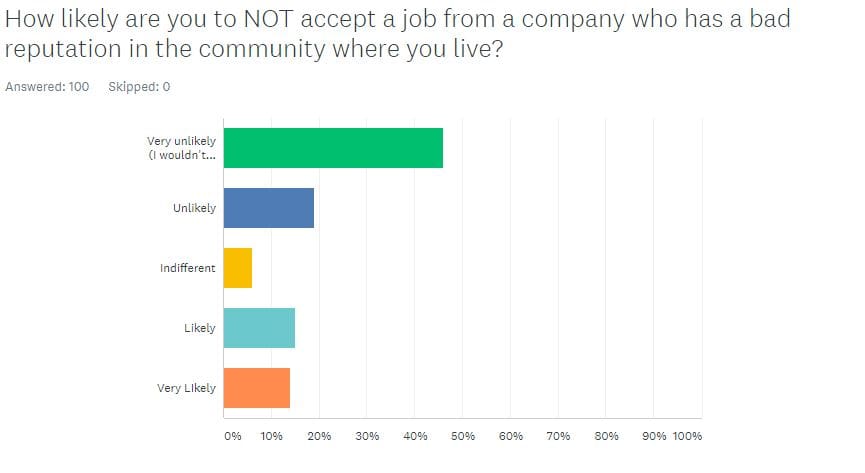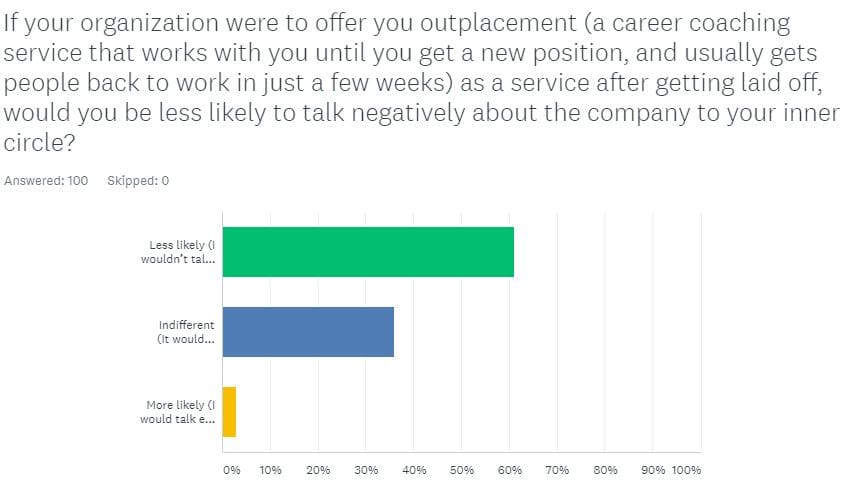
Preparing for a RIF?
Download our Essential Guide to Handling a Layoff
Request Pricing
Compare our rates to other providers
Layoffs and reductions in force (RIFs) are a stressful time for everyone at an organization. While there are a ton of great articles out there about HR’s role during these trying times, one aspect of reduction events goes shockingly under reported: how it can impact your employer or corporate brand.
To help change that, we’re going to go over everything you need to know about your employer brand and how reduction events – even temporary ones – can impact it negatively. Plus, we’ll go over the best ways to monitor the health of your brand through employee surveys.
Let’s jump right in.
What Is Your Employer Brand?
First off, what do we mean when we say ‘employer brand?’
Well, to put it simply, it’s how the outside world looks at your company. It’s your reputation. It’s what makes people want to do business with you or not. It’s what makes top talent want to work for you or tell their friends to not work for you. In other words, it’s super important.
As we all know, reputations take years and years to build but can be lost overnight. While there are many reasons for a reputation to tank, a poorly executed reduction event is a big one. It’s also one that can be easily avoided if you take the necessary steps.
The sad fact of the matter is that during a reduction event, employer branding is the last thing on HR’s mind. Why? Because there is a ton of other work to be done.
This shouldn’t be the case, though, because a poorly executed event that damages your employer brand can seriously impact your organization for years to come.
Let’s look into that a bit more.
How Employer Branding Impacts Your Overall Organization
There are quite a few things that can go sideways if your employer brand is damaged. In today’s Glassdoor world where employees, customers, and business partners are all empowered through technology to report their experiences with your company, your reputation is one of the most important things you have because it can impact just about everything.
For example, if you do not treat your outbound employees with respect and dignity, doing all you can to make sure they are set up for success, future employees won’t want to work with you either. Without having new, top-tier talent coming to your organization, you could potentially wind up hurting your bottom line all because your ex-employees reported their negative experience.
To demonstrate this, we took a survey. Here are the results:

You can also turn customers away, too. Nowadays, customers are more empowered than ever to research your company and, compounding that, customers are more and more likely to spend their money on organizations that adhere to their morals, meaning that if your company doesn’t treat their employees properly, you could be hurting your bottom line in many different ways.
But how are you supposed to manage your employer brand when you have to have a reduction event? Is there a sure-fire way to make sure you aren’t losing potential talent or customers?
Yes! It’s all about how you handle your layoff.
How Do You Protect Your Employer Brand When Holding a Layoff?
A general rule of thumb here is to treat your outbound staff members the way you would want to be treated if it were you being let go.
If you simply kick people to the curb, you’re setting yourself up for disaster down the road.
Layoffs are all about the care you give to your exiting staffers even though you know that they are leaving your organization. For many companies, the layoff process is a one-size-fits-all procedure that gets the person offboarded as quickly as possible without any care given to how the person will be after they leave.
This is the wrong way to do things.
You need to set up outbound staffers for success so that the last thing they remember about your company isn’t that they were kicked out and left to fend for themselves, but that you were there helping them get back on their feet.
This is where outplacement comes in.

As a refresher, outplacement is a service provided to exiting staff members that helps them get back to work faster than them doing it alone. The service combines top notch career coaching with digital tools to help your employee craft a new resume, update their social profiles, find job postings, post to job boards, make new connections, prep for interviews, and eventually land a job.
In short, outplacement – at least the providers worth their salt – will ensure you that your staff members will find a new job without going bankrupt and without blaming you for their layoff.
That last bit is what we’re focused on today. By providing a great severance package and outplacement support, your staff members – both those who you have let go and those that ‘survive’ the layoff – will understand that your company is doing all it can to make sure people are set up for future success.
If you provide this level of support, you’ll be well on your way to protecting your employer brand, retaining that reputation you have worked so hard to gain.
Now let’s look at ways you can monitor your brand during these trying times to ensure that everything you’re doing is working.
Use Employee Surveys to Monitor Your Employer Brand
To make sure that your plan is working to the best of its ability, you should go straight to the source: your employees.
The best way to see how a reduction event is impacting the morale at your organization is to simply send out a survey to your employees to gauge their mood, how they feel about the layoff, what you could be doing better, and more.
One of the best types of questions you can ask your employees is to gauge your performance on a bunch of different things. For example, you could ask:
1) On a scale of 1-10, how satisfied are you with the things listed below at [organization name]?
- Opportunity to grow
- Opportunity to learn new things
- Company’s offering (products and services)
- Customer satisfaction
- Ability to generate new ideas
- Level of responsibility
- Modern workplace
- Participation in decision making
- Salary
- Benefits
- Relationship with supervisors
- Relationship with coworkers
- Teamwork
- Work-life balance
- Flexible working hours
- Work from home
This will give you a baseline of how your current staff feels about your business’ actions across the board.
You can then ask questions such as, what made you apply for the job you have, what would be the primary reason for you to search for a job elsewhere, etc. You don’t need to go in and ask exactly how the layoff event impacted the organization. Instead, aim to get a general feel of how well your staffers are fairing.
Make sure to always give staff members room to write in about their answers to provide more details. Sure, you can have a simple slider that has them rate from one to 10, but allowing them to explain why they gave a 10 or why they gave a one will be far more beneficial.
You should also provide surveys to those outside of your company as well, because this is a great way to gauge how the general public feels about your organization.
For example, you could ask people you do business with or people that are applying to positions at your organization what their opinion is of your company, if they would be interested in working at the company if a position becomes available, how they heard about your company, etc.
These questions will help you gauge your reputation and to find out if you have an organization where people want to work, which means you are attracting the best talent.
How Do You Get People to Fill Out the Survey?
This is a great question. After all, if you make a survey, it doesn’t guarantee that people will fill it out.
You have a bunch of options here. First, you should allow people to answer anonymously to make sure that they are completely honest and do not have a reason to lie. This is vital if you want accurate information.
To entice them to fill out the form, you can use systems that randomly select a user who has filled out the form and awards them with a gift card. You can also provide gift cards to everyone who fills out the survey. Again, there are ways to do this anonymously.
Analyze Your Results
After you have collected information, you can start to analyze your results. If you are having a downsizing event or some other type of reduction in force, you can look at how your staff members answered before and after the event to gauge if it impacted your brand at all.
We highly recommend that you simply make the survey process part of your quarterly review process, which will allow you to monitor your employer brand even when nothing major is shaking things up. If you do, you’ll be able to proactively address issues and set everything back on the right track.
You should do the same when it comes to outside reviews, too. Find ways that align with your corporate culture to have clients, potential clients, potential hires, and more to fill out the survey to see where you stand. Also, monitor your company’s Glassdoor page and other reporting sites because online reviews are vital in today’s modern age.
If you do all of these activities, you will be able to see how your reduction event has gone over with the public and with your existing staff members. Surveys are a great way for people to let you know what they think and how your business actions are impacting your talent strategy, which then impacts your bottom line.
Want to learn how to properly handle reduction events in more detail? Check out some of our resources here:
In need of outplacement assistance?
At Careerminds, we care about people first. That’s why we offer personalized talent management solutions for every level at lower costs, globally.


